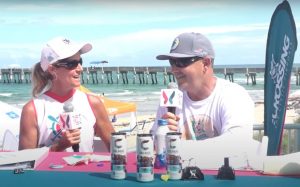Recap of the 2024 Crossing for Cystic Fibrosis from Alex’s Perspective

The 2024 Crossing for Cystic Fibrosis was an unforgettable experience. My team and I, competing as a 4-person relay, paddled our way to victory across the Gulf Stream, covering over 80 miles from Bimini in the Bahamas to Lake Worth Beach, Florida. The journey tested our endurance and teamwork, and it was all for an incredibly worthy cause—raising funds and awareness for cystic fibrosis (CF).
This year’s event brought together a passionate community of paddlers, volunteers, and supporters, all driven by the desire to improve the lives of those affected by CF. The Piper’s Angels Foundation organized the event impeccably, ensuring safety and camaraderie throughout the challenging course. The beautiful yet unpredictable ocean conditions added to the adventure, making our win even more gratifying.
As co-owner of Zahntechnique, I am deeply grateful to our clients who contributed to our fundraising campaign. Your generosity not only motivated us but also made a tangible difference in the lives of CF patients and their families. Thank you for your unwavering support and for helping us make a significant impact through this event.
For more details on the Crossing for Cystic Fibrosis, visit the official Crossing for Cystic Fibrosis website.
2024 Crossing For CF Livestreams
In case you missed it, you can watch our beach landing and award ceremony livestream for the 2024 Crossing For CF below!
2024 Crossing For CF Award Ceremony Livestream
2024 Crossing For CF Beach Landing Livestream Here
Zahntechnique Removable Webinar Series
At Zahntechnique, we’re always focused on educating and consulting with our clients about the latest and most important topics in dentistry. This summer, we have something special prepared to help you enhance your skills in removable dentistry, so you’re equipped to assist your patients, even with the less favored treatment approaches – removable.
Together, let’s turn these into our favorites. In reality, removable dentistry is the foundation of almost every complex treatment, whether it’s a flipper for a single-tooth implant, a full denture, or an implant-retained overdenture. We’re here to support you and meet both your needs and those of your patients.
Below are the topics for our upcoming webinars, which are divided into six easy-to-watch modules.
Module 1. Basic Foundation to Removable Dentures and Partial Dentures
Wednesday, August 14, 2024
Removable dentistry may not be a favorite among many dentists and their patients, but it is crucial for providing comprehensive care, especially for those with complex restorative needs. Not everyone can afford fixed implant restorations, so we need modern approaches to offer viable solutions for edentulous patients. I am confident we can continue to innovate and elevate the standards in removable dentistry.
Learning Objectives:
• Understand the fundamental components of removable dentistry
• Clearly describe the necessary steps to achieve successful results
• Utilize models, custom trays, and bite blocks to establish a VDO, ensuring clear communication between the dental office and laboratory
• Save chair time and appointments
Module 2. Analog Removable Full Dentures and Partial Dentures
Wednesday, August 21, 2024
Smiling from ear to ear? There are many advantages to complete and partial dentures. They are designed to closely resemble natural teeth, so there should be no noticeable change in appearance. New advancements help dentures appear more natural. Dentures are cost-effective and durable with proper maintenance, improving chewing functions, enhancing appearance, improving speech, and benefiting patients’ nutrition.
Learning Objectives:
• Learn the steps to confidently approach removable dentistry
• Discover the best methods to achieve amazing results for patients
• Follow a step-by-step guide from start to finish
3. Digital Removable Full Dentures and Partials
Wednesday, August 28, 2024
The world is going digital, and dentures are no exception. Full dentures are one of the last frontiers where we still hesitate to go fully digital, but there’s no reason to wait. Workflows and materials are available to plan, design, and fabricate dentures and partials digitally. This module will guide you through digital record-taking and the steps needed to plan and execute digital dentures and partials with your laboratory.
Learning Objectives:
• Identify the necessary records for digital dentures
• Follow a step-by-step process from start to finish of digital dentures
• Explore available materials
Module 4. Implant Over Dentures – Analog/Digital
Wednesday, September 4, 2024
Fixed implant hybrid dentures are a common restorative solution in today’s dental practices, but there’s more than just screw-retained hybrids. What if the clinical or technical situation doesn’t allow for a fixed solution? Aesthetically or economically, we may need alternatives. The Over Denture module will show and explain viable options beyond fixed hybrids, whether analog, digital, or a combination. We can plan, design, and execute great overdenture solutions.
Learning Objectives:
• Identify necessary records, both analog and digital
• Follow a step-by-step process from start to finish
• Explore available material options
Module 5. Telescopes
Wednesday, September 11, 2024
The German Crown offers no moving attachments, is extremely stable in fit, and hygienic. Whether supported by implants, teeth, or a combination of both, telescopes are an excellent solution for many dental situations across different ages. This module will introduce you to the so-called German Crown and the possibilities of this restorative solution, whether for full arches or partials.
Learning Objectives:
• Identify necessary records, both analog and digital
• Follow a step-by-step process from start to finish
• Explore available material options
• Understand indications
Module 6. Attachment Bar Solutions
Wednesday, September 18, 2024
Fixed or not fixed, no questions asked. This overdenture type is ideal for patients seeking something very hygienic, super aesthetic, and easy to maintain. In this module, we will explain the advantages and workflows necessary to achieve what is likely one of the best solutions for full arch restorations. Whether digital, analog, or a combination, we can employ multiple ways to reach the final destination for this kind of solution.
Learning Objectives:
• Identify necessary records, both analog and digital
• Follow a step-by-step process from start to finish
• Explore available material options
• Understand indications
Please join us as we delve into these exciting topics and elevate your practice in removable dentistry! Click here to register for the Zahntechnique Removable Webinar Series.

This continuing education activity has been planned and implemented in accordance with the standards of the ADA Continuing Education Recognition Program (ADA CERP) through joint efforts between Dental CE and Zahntechnique. If tuition was collected, Dental CE Solutions is not responsible for any reimbursement due to cancellation of an event. Reimbursement is the sole responsibility of Zahntechnique. Zahntechnique reserves the right to cancel a course no later than 14 days prior to the course date. Dental CE Solutions is an ADA CERP recognized provider. ADA CERP is a service of the American Dental Association to assist dental professionals in identifying quality providers of continuing dental education. ADA CERP does not approve or endorse individual courses or instructors, nor does it imply acceptance of credit hours by boards of dentistry. Dental CE Solutions designates each activity for 1 continuing education credit. Concerns or complaints about a CE provider may be directed to the provider or to the Commission for continuing Education Provider Recognition at CCEPR.ADA.org
Next-Level Shade Taking with OptiShade
If you are reading this, you should already be familiar with basic shade taking protocols. If not, please see my earlier post titled “A Simple Shade Taking Protocol”. If you have already read that post, let’s dive in.

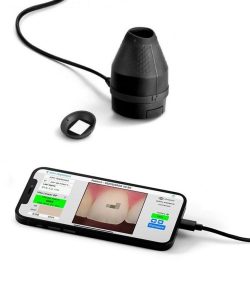
Understanding that all cases are different and have varying levels of complexity, we have tools and equipment to support us in getting more detailed and accurate. One of the most important tools is a DSLR or mirrorless camera with a macro lens, which should be basic equipment in every dental office and dental laboratory. To get to the next level, we can also utilize a shade acquisition technology called OptiShade.
OptiShade is a dental device and software developed by Style Italiano. It is designed to assist dentists in accurately determining tooth shades for restorative procedures such as crown and bridge work, veneers, implants, and composite fillings. OptiShade utilizes advanced technology to streamline the shade-matching process, resulting in more precise and consistent color matching outcomes. At this current time, OptiShade is only compatible with Apple devices such as the iPhone and iPad.
Here’s an overview of why a dentist should consider using OptiShade:
- Accuracy: OptiShade employs advanced algorithms to analyze various factors such as lighting conditions, tooth structure, and surrounding tissues to provide highly accurate shade matching results. This helps dentists achieve optimal aesthetic outcomes for their patients.
- Efficiency: By automating the shade-matching process, OptiShade saves time for both dentists and patients. Dentists can quickly determine the appropriate shade without the need for manual comparisons, reducing chair time and improving workflow efficiency.
- Consistency: OptiShade helps maintain consistency in shade matching across different procedures and patients. This ensures that restorations blend seamlessly with the natural dentition, enhancing overall smile aesthetics.
- Patient Satisfaction: Accurately matched restorations contribute to improved patient satisfaction. Patients are more likely to be pleased with the appearance of their dental restorations when shades are precisely matched, leading to greater confidence and trust in the dentist’s skills.
Overall, OptiShade offers dentists a reliable tool for achieving accurate, efficient, and aesthetically pleasing shade matching results, ultimately leading to improved patient outcomes and satisfaction.
In our experience, OptiShade is very good in comparison to many other shade taking devices available on the market. Important to say, to utilize the OptiShade to its fullest capacity, the dental office and the laboratory must have the device.
Please click here to read more about OptiShade. OptiShade is distributed worldwide by Smile Line.
We’re thrilled to announce an exclusive promotional offer just for you! For a limited time only, you can purchase the OptiShade at an unbeatable price of $1,865.95, plus shipping (prices subject to change without notice). This incredible deal is made possible by Smile Line with the special discount code OPTI24.
- Regular Price: $1,985.95
- Promotional Price: $1,865.95
Disclaimer:
Please be advised that Zahntechnique does not receive any commission or incentives from the purchase of the promotional OptiShade offer mentioned above. This exclusive discount is provided solely by Smile Line USA and is not affiliated with Zahntechnique in any way.
This promotional offer aims to provide our valued clients with exceptional savings and value on OptiShade products.
A Simple Shade Taking Protocol
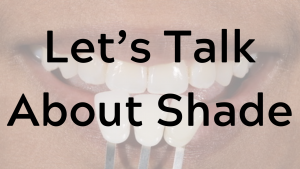
Overview
Shade matching in aesthetic dentistry can present challenges, but with careful consideration and proper protocols, it can be successfully achieved.
Material Selection
Material selection plays a crucial role in achieving an optimal match for the final restoration. Whether it’s zirconia, Lithium Di-Silicate, PFM, layered, or monolithic, the choice depends on factors such as the patient’s tooth shade, characterization, and translucency. It is advisable to entrust the decision to the dental technician, who possesses extensive experience with various materials.
Communication
Effective communication is paramount throughout the shade matching process. When the laboratory is local, arranging for the patient to visit and undergo shade matching directly with the technician is ideal. However, if the laboratory is located elsewhere, a specific protocol should be followed.
Protocol
The protocol involves capturing various photographs:
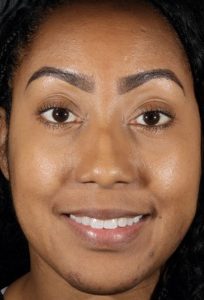
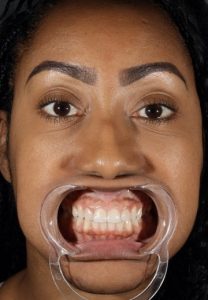
1. Full Face
Full face photo, including a smile, and a retracted full-face photo.

2. Shade Tabs
Close-up photo of the aesthetic area to be treated, using the closest matching shade tab, positioned with the incisal edge facing adjacent to the tooth being matched.
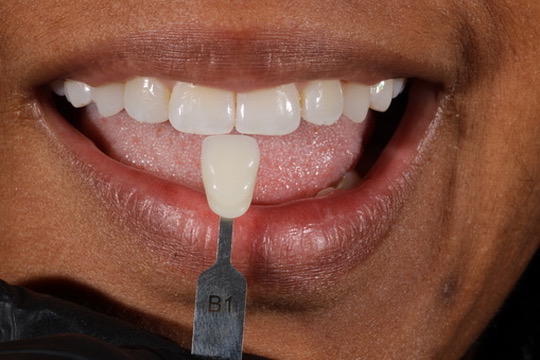
3. Darker Shade Tab
Repeat the close-up photo as in Step 2, but with a shade one step darker
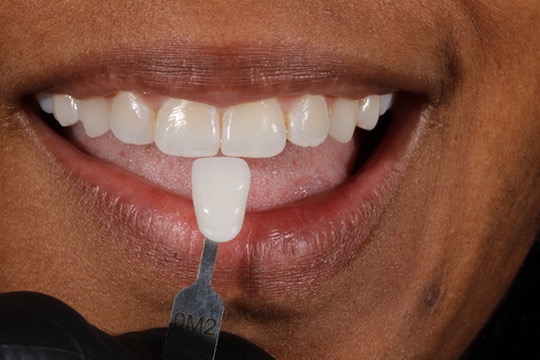
4. Lighter Shade Tab
Repeat the close-up photo as in Step 2, but with a shade one step lighter.
5. Stump Shade Tab
When applicable, take a stump shade photo with the closest matching shade tab.
Tips
- Ensure that the shade tabs are clearly visible and readable in all photographs.
- Maintain a consistent camera angle to avoid distortions caused by light reflections.
- Target the camera to the facial aspect of the tooth with a slight downward angle; angling from the incisal edge upwards should be avoided.
- Photography equipment, such as ring flashes or twin flashes, should be carefully calibrated to prevent overexposure, which can hinder accurate shade matching.
- Avoid using softboxes or filters for shade photography, as they can introduce errors.
This protocol provides a fundamental workflow for shade matching. However, personalized guidance and assistance can be provided to ensure confidence in treatment planning for aesthetic cases.
I am available to personally review this protocol with you, ensuring readiness for your next patient’s aesthetic treatment plan.

